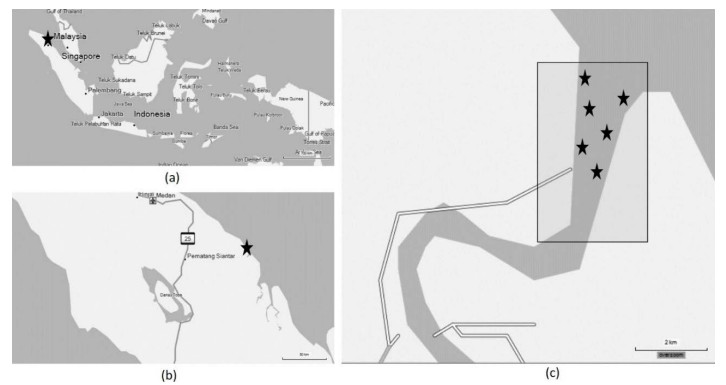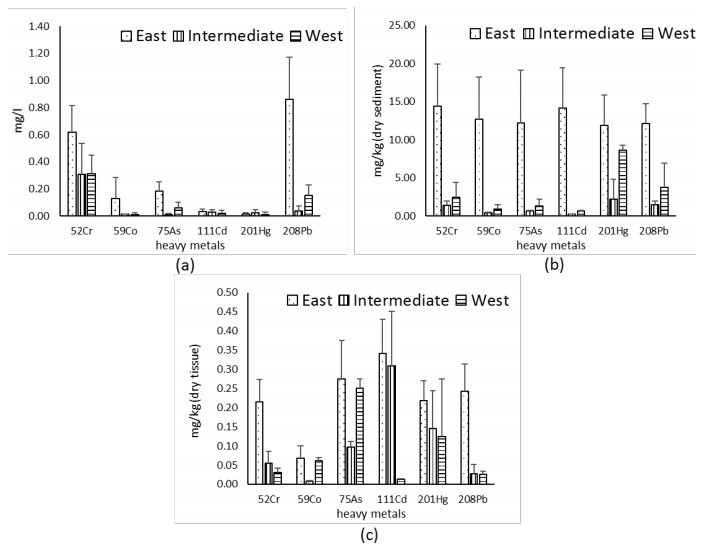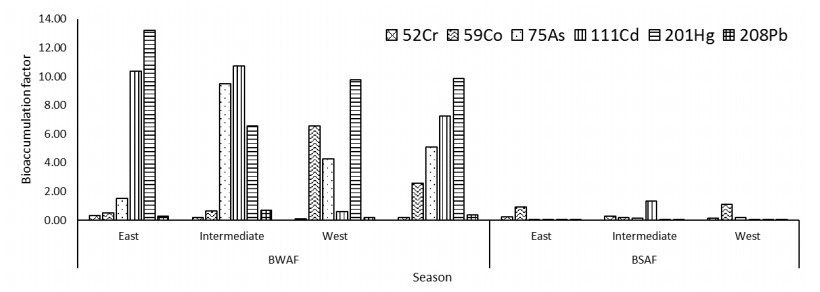A problem of food safety may rise in benthic estuary organisms such as the bivalve mollusc of Anadara granosa, as dangerous metals in environment may accumulate in their soft tissue. Fluctuation of accumulation may also happen, as there are factors that influence the amount of pollutants in water environment. This research aimed to analyze the seasonal pattern (Indonesian east, intermediate, and west monsoon season) of heavy metals (Cr, Co, As, Cd, Hg and Pb) accumulation factor in the soft tissue A. granosa and evaluate the use of mollusc as bio-indicator in metals pollution. The study had been done on the estuary of Tanjung Balai, North Sumatra, Indonesia. Heavy metal from water, sediment, and soft tissue of A. granosa were extracted by microwave digestion and analyzed by ICP-MS (Inductively Coupled Plasma-Mass Spectrometer). Result of the study showed that the heavy metals accumulation in the soft tissue of A. granosa was as follow Cd > As > Hg > Pb > Cr > Co and between 0.01–0.31 mg/kg. The concentration may consider as safe, which is below the maximum allowable limits for marine products. Meanwhile, a significant (P < 0.05) heavy metals contamination was detected higher in the beginning east monsoon season. Thus, temporal variation should be considered in food safety monitoring program on fisheries products, which usually only collected once per year. Moreover, BWAF (bio-water accumulation factor) was detected significantly (P < 0.05) higher than BSAF (bio-sediment accumulation factor). The results also showed only Cr and Pb had a significant relation (P < 0.05) between their accumulation in environment and in the mollusc. Therefore, environmental parameters need to take into account when using bivalves as indicator of heavy metal pollution since seasonality could affect the absorption of heavy metals.
1.
Introduction
An increase in human activities that been done without proper pollution control may release heavy metals pollutant into rivers and also estuaries environment. Industrialization, transportation, and other human activities are suggested as the cause of the increasing heavy metals contamination in estuaries [1]. Studies in estuary region in several countries, e.g. India, China, Malaysia, and Indonesia, have shown accumulation of heavy metals in estuaries water and sediment [2,3,4,5,6,7,8,9]. Thus, the organisms that live at coastal region may also accumulate those substances in their body. The accumulation was found higher in marine bivalves or molluscs, due to their filter feeding characteristics, can concentrate higher amount of heavy metals compare to their environment [10]. Therefore, marine bivalves are usually used as bio-indicator for heavy metals contamination in marine environment [11]. Polymesoda expansa, Brachidontes variabilis, Mytilus galloprovincialis, and Anadara granosa, are example of marine molluscs that proposed by other studies as bio-indicator for heavy metals contamination in marine environment [12,13,14].
Although many metals are essential biological elements, heavy metals are toxic persistent non-biodegradable substances above certain threshold concentrations and have been related with adverse effects on animals and human health [15]. A recent study showed a malformation of green molluscs cultured in Jakarta Bay, Indonesia, as the consequences of heavy metals pollution in the environment [16]. Moreover, a weaker defensive system in human body was detected as an increase in accumulation of heavy metals Cu, Pb and Cd [17]. Therefore, an attention into food safety has risen as marine molluscs are commercial seafood products. There were studies that evaluate the human health risk of mollusc consumption related to concentration of heavy metals [18,19].
However, variations on the order of heavy metals accumulation was found leading to health risk results. For example, the order of accumulation from a study was found as Cd > Hg > Zn/As > Cu > Cr/Pb, while other studies may found as Cu > Cr > Cd > Hg [20,21]. The variation may happen on spatial and also on the same site in seasonal scale [22]. Therefore, a baseline study of temporal variation on heavy metals accumulation in molluscs is needed, to the further study of mollusc health risk evaluation form a particular location as commercial fisheries food products. Moreover, the use of mollusc as bio-indicator in heavy metals pollution should also be evaluated. There are many variations on result of correlation between heavy metals in environments and in the soft tissue of mollusc. Hydrological fluctuations of the rivers flow to estuarine areas may relate on variations of pollutant accumulation in marine organism [23]. This study presents the seasonal pattern (Indonesian east, intermediate, and west monsoon seasons) of heavy metals (Cr, Co, As, Cd, Hg and Pb) accumulation in the soft tissue Anadara granosa from the estuary of Tanjung Balai, North Sumatra, Indonesia, and also the possible correlation between the amount of heavy metals contamination in the environment and mollusc.
2.
Materials and method
2.1. Sample collection, preservation, and preparation
Anadara granosa samples were collected from the estuary of Tanjung Balai, North Sumatra, Indonesia. A. granosa samples were taken randomly from 6 spots, as replication, on the site of the molluscs commonly captured by local fishermen (Figure 1). Samples were collected in the beginning of east monsoon season (dry season in April 2018), Intermediate (August 2018), and west monsoon season (rainy season in November 2018). After collection, the attached mud and other debris were cleaned. Soft tissue from 100 individual species were taken from each spot and homogenized. Moreover, upper section of sediment (0–20 cm) and bottom section of water at each sampling spot were also collected. Sediment samples were taken by grab sampler, while water samples by nansen bottle. All samples were stored in plastic boxes (sediment and A. granosa) and bottles (water). All of samples are stored in a coolbox at low temperature that maintained with ice for transportation to the laboratory. In the laboratory, water samples were filtered through 0.45 µm filter. Meanwhile, mollusc soft tissue and sediment were dried at 40oC and then grounded to powder.
2.2. Heavy Metal Analysis
The water, sediment, and soft tissue of molluscs were digested by HNO3 (Superpure, Merck, Germany) in digester microwave according to Siregar et al. [24]. Heavy metals (Cr, Co, As, Cd, Hg and Pb) were determined by Inductively Coupled Plasma Mass Spectrometry (ICP-MS) Agilent 7700x in Helium high matrix mode. Calibration was performed by standard solution in 6 concentrations of 52Cr, 59Co, 75As, 111Cd, 202Hg and 208Pb isotopes. The accuracy of sediment and soft tissue of A. granosa analysis was validated by sediment standard reference materials PACS-2 (NRC, Canada) and fish homogenate standard reference material IAEA-407, which showed recovery rate for all targeted heavy metals was between 80–110%. Meanwhile, validation of water samples was accessed by spiking method. A 5 µg/L of standard solution was added in artificial seawater, which showed recovery rate between 85–105%.
2.3. Data processing and statistical analysis
All data were tabulated by the group of season (east, intermediate and west). Multivariate Discriminant Analysis (DA) was used to define the pattern of heavy metals at each temporal season. BWAF (Bio-Water Accumulation Factor) was calculated as a ratio between heavy metals concentration in molluscs to water, while BSWF (Bio-Sediment Accumulation Factor) was calculated to concentration in sediment. Linear stepwise regression analysis has been applied to define the correlation of heavy metals contamination in environment and mollusc. All statistical analyses were conducted with Past Statistical Software v3.08 [25].
3.
Results
The order of accumulation in water layer was found as Cr > Pb > As > Co > Cd > Hg. Meanwhile, different order was found on heavy metals accumulation in sediment (Hg > Cr > Pb > Cd > As > Co) and the soft tissue of molluscs (Cd > As > Hg > Pb > Cr > Co). A significant difference (P < 0.05) of accumulation in different season was detected in almost all metals species in water, sediment and molluscs, except for Hg in mollusc, as well as between Hg and Cd in water (Figure 2). Strong discriminant functions (78.15–94.70%) that consist of almost all variables may indicate all of the heavy metals were accumulated higher on east monsoon season, particularly in sediment and mollusc (Figure 3). Small overlayed area of 95% confidence ellips between accumulation of heavy metals in water in different seasons might be caused by the insignificant concentration of Hg and Cd.
Calculation of bioaccumulation factor showed a significant different between BWAF and BSWF (Figure 4). Accumulation factor of heavy metals to water was detected significantly (P < 0.05) higher than that to sediment. However, acumulation of heavy metals in water and sediment was not detected as the only factor that determined the amount of heavy metals in the soft tissue of A. granosa. Linear stepwise regression models revealed only two heavy metals (Cr and Pb) that had a significant (P < 0.05) and moderate (R2 adjusted > 0.5) determination stepwise regression model (Table 1). Both elements (Cr and Pb) were also constructed differently. Cr in A. granosa was found directly related to the amount in sediment, while Pb to the amount in water.
4.
Discussion
Tanjung Balai estuary is the section that relates Asahan River to the sea, one of the main principal rivers in North Sumatra Province that flows from Toba Lake in the center of the province. The river is surrounded by small rivers and canals throughout several cities flow into the coast, which potentially carries effluents from industral and household regions. The high amount of Cr and Pb in the water can be attributed to the boat traffic [26]. Similar results were also found in Jiaozhou Bay-China and Trabzon Harbour-Turkey, the high amount of Cr and Pb was suggested to relate with harbor and vessel activities in the coastal region [22,27]. Leaded petroleum is commonly used in Indonesia, as fuel for local vessels. Meanwhile, the characteristics of physiochemical in sediment may affect the level of heavy metals absorption. For example, high nutrient level enhances the adsorption of Pb and Cu in sediment, while low oxygen level decreases the potential bioavailability of both heavy metals [28]. All of the complex interaction factors may serve as the reason of the different pattern of heavy metals accumulation in sediment compared to that in the water.
Concentration of heavy metals in mollusc samples, which is between 0.01–0.31 mg/kg, is considered as safe for human consumption, as below the maximum allowable limits for marine products in various regulatory bodies [29]. The significant effect of seasons into heavy metals accumulation in studied samples is similar to the results in other studies, for example, oyster that was taken in winter and summer was detected to accumulate higher heavy metals than in other season at Meiling bay, China and Chabahar bay in Oman Sea [30,31]. However, seasonal effect may also be influenced by spatial location. For example, in tropical northern Vietnam region, accumulation of heavy metals in mollusc was found higher in the rainy season, while completely different results, lower accumulation in rainy season, was found in mollusc from Jakarta Bay, Indonesia, and coastal area of Bengal, Bangladesh [24,32,33]. In Indonesia, east monsoon season is typically a dry season with lower rainfall compared to intermediate and west monsoon season. It is supposed that low rainfall in dry season leads to lower water flow, and as a consequence, higher concentration of heavy metals is detected [34]. Moreover, dry season may primarily influence the water temperature [35]. Mollusc's metabolism may increase at higher temperature and therefore, the rate of water inflow into the animal also increase which lead to higher amount of heavy metals accumulation [31].
Accumulation factor in mollusc to water was detected higher than to sediment. This result is similar with other molluscs or snails studies [36,37]. The characteristic of filter feeder is the factor that make higher accumulation rate from water, which make molluscs have been widely used for water bio-monitoring indicator in coastal region. Even though it is varied, the most bio-water accumulation factor was detected with As, Cd, and Hg. These metals are known as the most toxic heavy metals among others [29]. Meanwhile, BSAF values showed that A. granosa from Tanjung Balai estuary suggests as micro-concentrator for Cd and Co, and de-concentrator for other heavy metals. Characteristic of BSAF is categorized as macro-concentrator (BSAF > 2), micro-concentrator (1 < BSAF < 2) or de-concentrator (BSAF < 1) [38]. Similar results are shown from the same species taken at western coastline of Malaysian region, demonstrated A. granosa as a concentrator for Cd and de-concentrator for Pb, Cr, Cu, and Zn [39]. A de-concentrator species means the organism capable to eliminate excessive trace elements or metals by releasing the metals into their environment [40]. Therefore, it imply that amount of heavy metals in the environment of A. granosa in this study has not exceed the capability of this organism to remove excessive or unwanted trace metals that may effect to their body.
The linear stepwise regression study showed that the concentration of heavy metals was not detected as the only factor to determine the amount of heavy metals in the soft tissue of A. granosa. Toxic heavy metals, such as Cd and Hg, were not found to accumulate linearly from the environment to the soft tissue of mollusc. Low content of these metals in mollusc may not represent the same concentration in the environment. Factors of biology (physiology, cycle of reproduction, metabolism, development and age, food availability, temperature), chemistry (metal concentration, speciation, and bioavailability), and other environmental characteristics (e.g. temperature and food avability) that may vary in seasons, could affect the intake of heavy metals accumulation [41,42,43]. For example, it was found recenty that accumulation of Hg into marine bivalves may go trough natural and microplastic pathways [44]. Moreover, the effect of contaminants into biochemical and physiological parameters on marine bivalves also vary, depands on the variability of environmental factors [45]. Therefore, precautions will be needed to use bivalves as bio-indicator within a monitoring program, as environmental parameters need to take into account.
5.
Conclusion
Temporal variation may affect heavy metals accumulation in the soft tissue of A. granosa. Moreover, the accumulation of heavy metals in A. granosa may not only depand on the amout of the heavy metals in the environment. Therefore, as the results showed a significant influence of seasons into the variation of heavy metals contamination in molluscs, environmental parameters need to take into account when using bivalves as bioindicator of heavy metal pollution in food safety monitoring program of fisheries product.
Acknowledgments
This study was funded by the Indonesian Research and Development Center for Marine and Fisheries Product Processing and Biotechnology. Our thanks goes to Sri Iswani and Anggang Ayu Wardani at Indonesian Research Center for Marine and Fisheries Product Processing and Biotechnology who helped in sampling activities and sample prepration. Moreover, this study also thanks to Fish Quarantine and Inspection Agency in Tanjung Balai, for their assistence in sampling activities.
Conflict of interest
The authors declare that there is no conflict of interests regarding the publication of this paper.










 DownLoad:
DownLoad:






